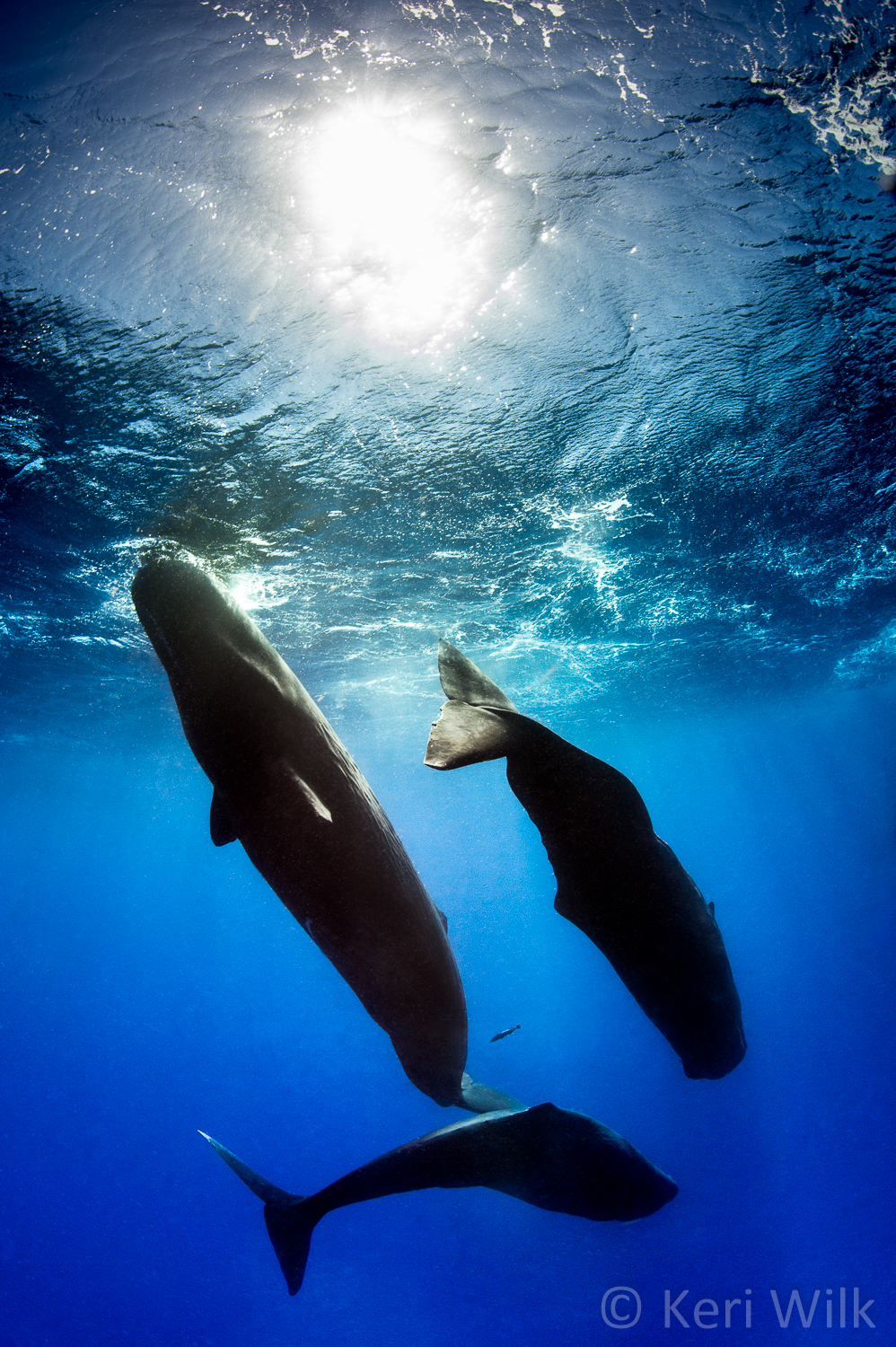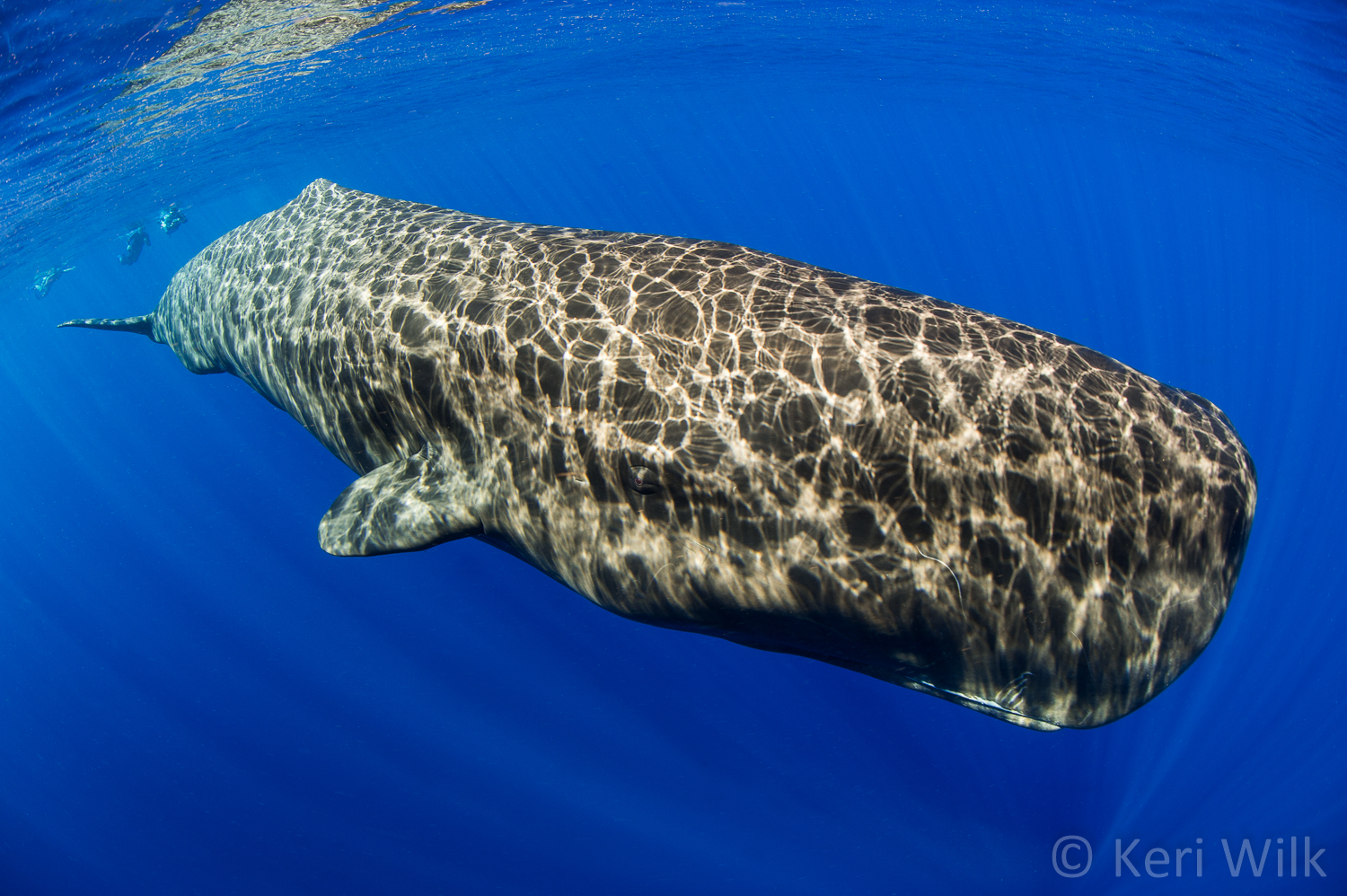DOMINICA SPERM WHALE 2020
Dominica
Officially known as the Commonwealth of Dominica, this small island is located between Guadeloupe and Martinique, midway through the chain of Lesser Antilles islands that separate the Caribbean Sea from the Atlantic Ocean. With volcanoes, waterfalls, rainforests, hundreds of rivers, and endemic flora and fauna, it's no surprise that this 300 square mile island has earned the nickname "Nature Island". And, that isn't even taking the marine life into account! Diving on the west coast is among the best in the Caribbean. Macro and wide angle photography subjects can be found on every dive, but Dominica's true uniqueness starts being apparent as soon as you venture offshore...
Sperm Whales
Sperm whales (Physeter macrocephalus) may have been portrayed as vicious human killers in Moby Dick, but in reality they're more like shy puppies the size of a bus. Well, they're also the largest and loudest predator on earth (up to 70 feet long, 60 tons, and 230 dB!), have the largest brain in the animal kingdom, have 2 lb teeth, and can dive over 4000 feet deep. Don't worry though, they feed primarily on squid, and have no recorded human fatalities.
The ocean floor along Dominica's west coast drops steeply to several thousand feet very close to shore, providing a calm and sheltered area for a large group of "resident" sperm whales to feed, mate, and socialize. Year round, they can be spotted very close to shore, cruising up and down the island's coast.
Permits
This unique sperm whale habitat has generated much attention for the island, resulting in whale watching becoming one of Dominica's most well-known activities. That is, whale watching from a boat, from a safe distance away, with a few dozen other oglers, for a short period of time. As marine enthusiasts and underwater photographers, I'm sure you'll agree that this doesn't sound very appealing. So, why not just jump in the water to see them better? Well, because such in-water encounters are strictly regulated in order to ensure the welfare of the whales, which are now considered national treasures. Over the past few years, Dominica's government has been issuing a few carefully-controlled number of in-water permits to select individuals - researchers, reputable underwater expedition leaders, documentary film crews and, for the past 7 years --- me.
With an in-water marine mammal permit, up to 3 permit members can be in the water simultaneously with any animals that we find along the coast. Dolphins? False-killer whales? Pilot whales? They're all fair game (we’ve encountered all of these, and more…). For 8 hours a day, we'll be on a privately-chartered boat, run by one of Dominica's most experienced boat captains searching for . If we don't find whales one day, we can take a leisurely cruise along the coastal villages, stop at some shallow reefs to snorkel, explore large sargassum floats, or visit some FADs (Fish Aggregating Devices) for interesting photo opportunities. The boat is ours, and we can do what we want with it, within reason.
2020 Dates
The permit dates listed below can each technically be submitted with a maximum of 8 names (including me). However, 8 people on the boat is just too many, in my opinion, so I'm keeping the number of guests on the boat down to 4-5 (excluding me/crew). This gives each guest significantly more in-water time with the animals.
- Permit 1: July 1-6 (6 days)
- Permit 2: July 8-13 (6 days)
- Permit 3: July 15-20 (6 days)
- Permit 4: July 22-27 (6 days)
Payments and Cancellations
A 40% deposit is required to reserve your spot, and full payment is due 90 days prior to your permit dates. Cancellations made before more than 90 days before the permit date will be refunded in full, less a cancellation/rebooking fee. Cancellations less than 90 days before the permit date will only be refunded if the spots are successfully refilled.
Trip Leader
I (Keri Wilk) will be leading my 2020 permits. This will be my 7th year in a row in the water with these whales, bringing my cumulative on-water tally to well over 1000 hours. Our captain and marine park guide are both seasoned veteran whale-spotters, who will help make sure that if there are whales around, that we'll sniff them out. If you need any help with your camera/housing, want to learn some helpful editing tips for whale images, or want to go into town after we get back to shore, I’m always happy to help!
Inclusions
Snacks on the boat
Permit fees
Captain/guide fees
8 hrs/day on the water (weather permitting)
Exclusions
Accommodations
Breakfast/Dinners
Alcoholic beverages (if you're nice, I might buy you a beer)
Gratuities for hotel/boat staff
Scuba diving
Airfare
Additional expenses (snacks, souvenirs, etc.)
Travel/Lodging
Flights: You'll need to fly in to Melville Hall Airport (DOM) before the first day of the block that you're in, and fly out the day after the last day of your block. There are a number of ways of getting to Dominica, but no one flies there direct from North America. You'll need to get to one of the main hubs, then take an inter-island flight for the final leg. Hubs include Antigua (ANU), Barbados (BGI), St. Maarten (SXM), Puerto Rico (SJU), Guadeloupe (PTP), and Martinique (FDF). Here's a link which contains loads of information regarding getting to Dominica:
Let me know if you’d like any help figuring out the best flight plan from your area!
Visas: As long as you are staying in Dominica for less than 21 days, and have a return ticket to satisfy customs officers, you won't need a visa to enter Dominica. However, please take a look at the following Dominica government website which contains much more information: DOMINICA VISA INFO
Lodging: **Due to the recent devastation that the island suffered from hurricane Maria, many of the hotels in the Roseau area have either ceased operation, or are operating at a diminished capacity. **
We recommend Ocean's Edge Lodge as home base, since it shares Dive Dominica’s dock, where the boat will be picking us up each morning. There are, however, other lodging options available. Seaworld Apartments offers similar quality rooms a few hundred meters north, but if you’d like a more luxurious experience, then Fort Young Hotel is where you might want to stay. Fort Young has its own dock, so if you choose to stay there, we can pick you up there each morning. I also know a few apartments that are across the street from Ocean’s Edge, which are the least expensive option, but can be a little rough around the edges. Let me know if you need any help deciding, or have any questions!
Itinerary
Whichever block you decide to join, the same schedule applies:
Day 0 - Arrive in Dominica. Make sure you speak with your hotel in advance to arrange an airport pick-up, or if you'd like me to arrange this, I'm happy to do so as well. Enjoy the mountainous ride across the island, then unpack, set up your camera gear, and get some rest, because we're starting bright and early in the morning!
Day 1-6 - Our boat leaves the Ocean’s Edge dock (unless otherwise noted) at 7:30am. We can meet for breakfast, or you're welcome to eat solo. After spending 8 hours on the water tracking whales (or whatever else we decide to do!), we'll come back to the dock - typically between 3:00 and 4:00pm, depending on whale activity and the consensus of the group. Dinner at Ocean’s Edge is excellent, but if you want to venture into the city for a wider variety of options, it's a pleasant walk, or a short taxi/bus ride away. Get lots of sleep - you will be exhausted!
Day 7 - Pack up, and get ready for the airport. I'll arrange the necessary transportation, if your hotel doesn’t. Make sure that you say goodbye to your new whale friends... they'll be waiting for you next year!
Since you're going through the trouble of getting to Dominica (you'll notice there are very few tourists, for this reason!), I strongly suggest extending your stay at least a few days before/after your whale block to do some diving, hiking, or general sightseeing. For the past few years, after each whale permit concludes, a subset of the group has always done the Boiling Lake hike (see photo above). It's not easy, but the journey is well worth the punishment! Google it!
Reality Check
Sperm whales are big, but the ocean is bigger. I can't guarantee that we'll see anything, but I can tell you about my experience for the last 7 years on these permits. In my first 3 years. I spent 55 days on the water looking for whales, and only had 10 days without any sign of whales. Those are pretty good stats, and are somewhat typical. Of the 45 days that we had whale sightings, another 16 of those days had limited in-water interaction with whales. On 25 of the remaining days we had great success tracking with a number of whales, spending the majority of each day doing drops into the water, and having some curious juveniles moderately interact with us. Finally, on the remaining 4 days, we encountered socializing sperm whales. This is the holy grail of sperm whale encounters, and is what we are looking for every day, with fingers crossed and lucky swim shorts on.
When 2 or more whales are socializing, they generally don't care about human presence (as long as you swim carefully!), so the whales become gigantic blank canvasses, which you can swim around and photograph however you'd like. They slowly bob up and down, rubbing dead skin off each other, inspecting us, and doing whatever else that sperm whales do, oblivious to us. IT IS INCREDIBLE. Cliché phrases like "life-changing" and "awe-inspiring" come to mind, but they don't do it justice. This type of encounter is fairly unlikely though --- my record so far is 4 out of 55 days (or 1/14, or 7%). It’s really just a numbers game - the more days you can be on the water looking (and listening with our hydrophones), the better your chances of finding a social group. Or, you could see nothing at all. That's the way nature works!
Packing List
Here are a few items that I recommended you bring:
Mask
Snorkel
Fins. Long free diving fins are not recommended, since we'll be getting in and out of the water frequently, and they tend to make more splashing noises that could scare the whales. But, bring them if you want!
3mm wet suit and/or dive skin (water temp is usually around 80F)
Underwater video/camera (NO strobes, unless you'll be doing some diving around the island separate from the whale encounters)
Light windbreaker
Long sleeved shirts
Sunglasses
Hat
Sunscreen
Rain poncho
Hiking shoes/boots (if hiking)
EYE CANDY
(click to enlarge)Other Details
NO SMOKING ON THE BOAT!
This trip is free-diving only - bubbles disturb the whales!
I can't guarantee any sightings... but it is VERY unlikely that we will see nothing.
This trip is geared strongly toward underwater photography/videography, but anyone can come!
Getting in and out of the boat, and keeping up with sperm whales can be very strenuous at times, so physical fitness is very important. On days that the whales don't want to stick around, you'll only be able to get shots if you are kicking alongside them, which can very quickly become exhausting. If you have existing heart problems, or are in otherwise poor physical health, then you probably should not be participating in this trip.
Sperm whales are huge, and unpredictable, and we'll be swimming in the middle of the ocean over several thousands of feet of water. You need to be comfortable in the water, and accept the inherent risks involved with such an activity.

































